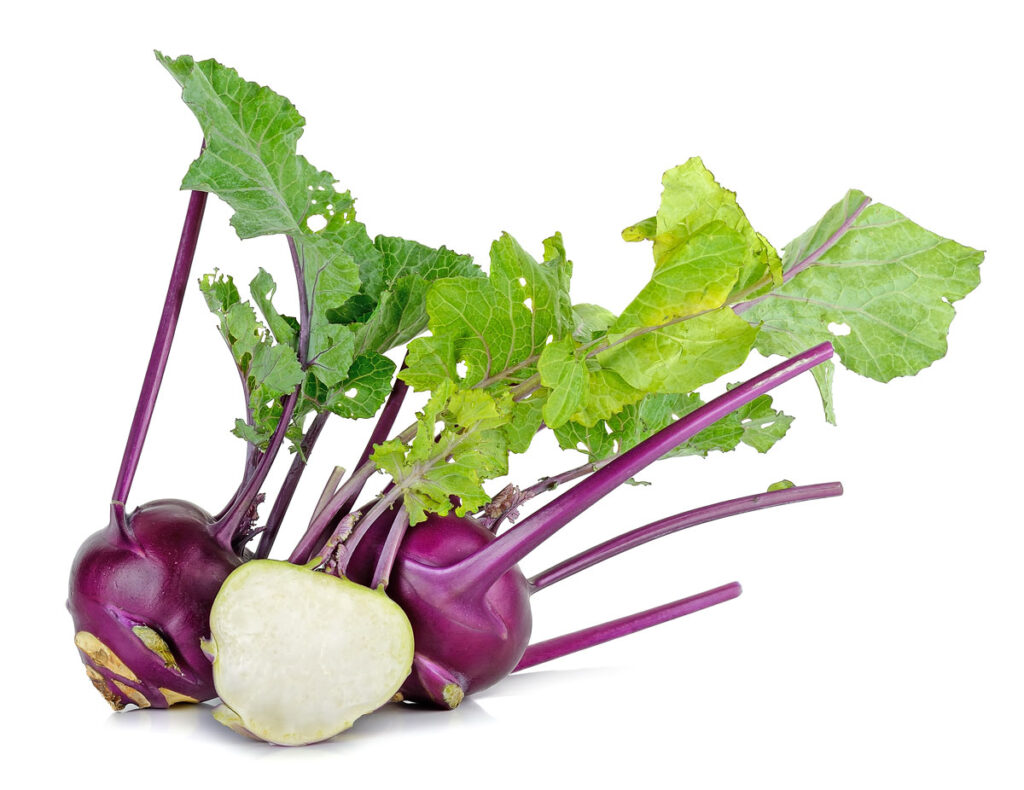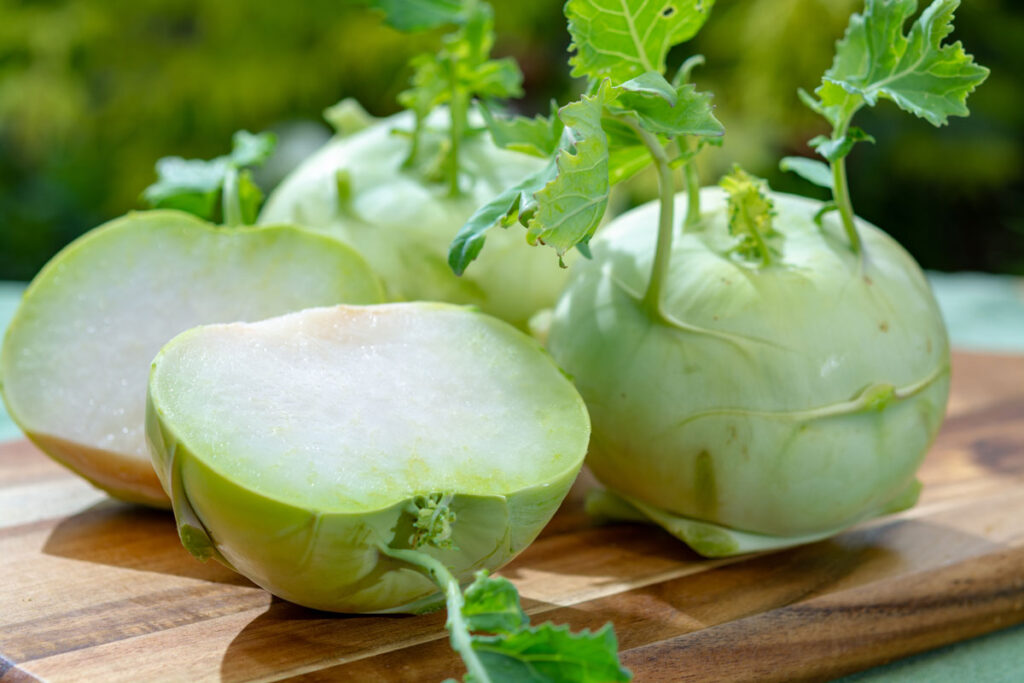Kohlrabi is one of the vegetables that you can quickly and easily grow in the garden. However, in order for the tubers to grow large and tender, there are a few things to keep in mind when cultivating them. Learn more about this, the best varieties and what trick you can use to harvest kohlrabi almost all year round in this post on Botany Guide.
Buttery kohlrabi is one of the most popular vegetables. Because of its mild flavor, it goes well with many dishes and is versatile in the kitchen. Fresh from your own garden, the healthy tubers are all the tastier. Growing it is quite easy, as kohlrabi is the ideal vegetable for beginners. The easy-care spring vegetable grows quickly, already a few weeks after sowing the first harvest. Thanks to the short duration of cultivation, regular sowings allow you to harvest several times a year.
Kohlrabi is one of the easy vegetables to cultivate, but the plants still require special attention in terms of nutrient and water supply so that they form thick tubers and do not become woody. Likewise, variety selection and sowing dates play an important role in nearly year-round harvesting.
Year-round harvest: There are early and late kohlrabi varieties.
Before you start growing kohlrabi in your own garden, you should first choose the right variety. Kohlrabi is one of the vegetables with a short cultivation period. How quickly it ripens depends on the variety. Generally, a distinction is made between early and late varieties, which are suitable for different seasons.
Kohlrabi comes in two colors
Light green kohlrabi is the best known. What many people don’t know is that the tender spring vegetable is also available with blue-purple tubers. However, you won’t find them in supermarkets, so they are often grown in gardens. Among the early and late kohlrabi, a distinction is made between white and blue varieties. Blue kohlrabi look more attractive in the vegetable patch, but usually ripen a little later than the white classic.

Contents
- 1 Staggered sowing dates for a regular harvest of kohlrabi.
- 2 Botany Guide Tip
- 3 Pre-growing kohlrabi in the house
- 4 The ideal kohlrabi location is warm and rich in humus.
- 5 Uniform water and nutrient supply ensure tender tubers.
- 6 Botany Guide Tips
- 7 Kohlrabi as a practical gap filler in the mixed culture.
- 8 Harvesting kohlrabi: How tender the tuber is depends in part on its size
- 9 Author
Staggered sowing dates for a regular harvest of kohlrabi.
Many first-time vegetable growers often sow seeds only once a year. However, once the kohlrabi is harvested, there is a lack of supply. In practice, therefore, staggered sowing dates have proved successful. If you sow smaller quantities several times, the kohlrabi will not ripen all at once, but with a slight time delay. In this way, you can regularly supply yourself with fresh tubers and better adjust the harvest quantities to your own needs. The ideal times for reseeding kohlrabi are shown in the Botany Guide Vegetable Seeding Calendar 2022. In the practical calendar you will find the sowing dates for over 50 vegetable varieties, including staggered sowing.
Kohlrabi direct sowing into the open ground
Kohlrabi is usually sown directly into the cold frame or open ground. Depending on the variety and region, this can be done from April to August. If you want to extend the kohlrabi season, you can preplant it indoors as early as February.
Botany Guide Tip
Growing kohlrabi under fleece extends the harvest season
Pre-grown seedlings can be planted out as early as March. To protect the kohlrabi from night frosts, it is best to cover it with fleece or foil. As soon as the first warm days of spring arrive and temperatures rise above 20 °C, it is necessary to ventilate well under the fleece. The same applies to foil tunnels, cold frames and greenhouses. Otherwise, kohlrabi will not form tubers because it is too warm for it.
Pre-growing kohlrabi in the house
- sowing
For precultivation on the windowsill, kohlrabi is sown in trays or in an indoor greenhouse and covered with a thin layer of soil. The seeds require temperatures of 16 – 20 °C to germinate. Once the seedlings have germinated, they should be placed a little cooler.
If the kohlrabi is too cold during cultivation, it will not form tubers
Temperatures should not fall below 12 °C during growing, otherwise the plants will not form tubers.
- pricking out
After about a week, the young cabbage plants can be pricked out into growing pots. More tips on growing vegetables in the article: Growing vegetables: Sowing, pricking out and planting out. - harden off young plants
Since kohlrabis are accustomed to the warm climate from pre-cultivation, they must first be hardened off before planting out. To do this, place the plants outdoors on mild days and bring them back indoors in the evening. Purchased young plants should also be hardened off as a precaution. If the plants are grown in a greenhouse, it is sufficient to open the windows a little during the day. - plant out kohlrabi
From mid-March, the first kohlrabi can be planted out in mild areas. These should not be planted deeper than in the previous crop in order to avoid growth stagnation. Early varieties are planted with a spacing of 25 x 30 cm, for late varieties it is 40 x 50 cm.
The ideal kohlrabi location is warm and rich in humus.
Vegetables are divided into low, medium and high growers depending on their nutrient requirements. As a medium grower, kohlrabi needs a humus-rich soil. Since it is very thirsty, this should always be evenly moist. It feels most at home in a warm and sunny to semi-shady spot in the vegetable patch.
Uniform water and nutrient supply ensure tender tubers.
In order for kohlrabi to form thick and tender tubers, it must be sufficiently watered and fertilized. It is important that the supply is as even and regular as possible. If the kohlrabi suffers from a lack of water on hot days and is then watered vigorously, the tubers may burst open. Due to its rapid growth, kohlrabi is dependent on quickly available nutrients. Here, however, low-dose but more frequent fertilizer applications are better for tuber formation than a few high doses. Fertilization should begin about six weeks after planting, at the latest when the first tubers develop. If the kohlrabi is not optimally supplied with water and nutrients, growth may be delayed or the tubers may become woody.
Botany Guide Tips
Mulching reduces water loss in the soil
A layer of mulch ensures that the soil does not dry out so quickly and is therefore ideal for thirsty kohlrabi. For mulching, you can use bark chips or lawn clippings, for example. The layer is best spread when the plants have reached a height of about 10 cm.
Support heavy tubers by mounding.
As soon as the kohlrabi forms the first tubers, you can mound the soil around it a little. This support gives the heavy tuber a better hold.
A lot of nitrogen makes kohlrabi taste coarse
Not only watering, but also fertilizing has an influence on the quality and taste of the tubers. Kohlrabi that have been fertilized with a lot of nitrogen develop a coarse aroma and give off an intense cabbage smell when cooked.
Kohlrabi as a practical gap filler in the mixed culture.
Because kohlrabi requires relatively little space and has a short growing season, it serves as an ideal gap filler on harvested beds. In this way, the often limited cultivation area can be used more effectively, especially with early varieties. In mixed cultivation, kohlrabi is a good planting partner for many other vegetables. It goes well with leeks, beet or strawberries, for example. However, when growing kohlrabi, you should pay attention to crop rotation. Like all cabbage varieties, kohlrabi is susceptible to cabbage hernia, a dreaded fungal disease. To prevent cabbage hernia from becoming a problem, kohlrabi must be grown in a different location in the garden the next year. At the same time, crop rotation allows the soil to recover somewhat.
Harvesting kohlrabi: How tender the tuber is depends in part on its size
After a certain size, kohlrabi becomes woody. The only exceptions are the ‘Superschmelz’ variety and the Strunkkohlrabi, whose tubers can grow very large without becoming woody. With all the others, don’t wait too long to harvest. Once the tubers reach about the size of a tennis ball, they are ready for harvest. At this size, kohlrabi is butter tender and tastes best. If you leave it on the bed longer, the tubers will become thicker and thicker, but they will tend to become increasingly woody.
Kohlrabi can be stored for different lengths of time
With kohlrabi, the shelf life varies depending on the variety. Early varieties taste best when fresh from the garden and used promptly. However, they can be kept in the refrigerator for up to two weeks. To extend the shelf life, twist off and remove the leaves beforehand. Late varieties of kohlrabi, which under good storage conditions can be kept until spring, are suitable for winter storage. Therefore, they are also called storage varieties.










